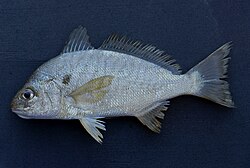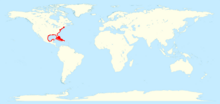Spot (fish)
| Spot | |
|---|---|

| |
| Scientific classification | |
| Kingdom: | |
| Phylum: | |
| Class: | |
| Order: | |
| Family: | |
| Genus: | Leiostomus
|
| Species: | L. xanthurus
|
| Binomial name | |
| Leiostomus xanthurus Lacépède, 1802
| |

| |
| Spot range map | |
The Spot (Leiostomus xanthurus) or Norfolk spot[2] is a small short-lived saltwater fish in the family Sciaenidae. The species inhabits estuary and coastal waters from Massachusetts to Texas, and derives its name from the prominent dark spot behind each gill. It is the only species in the genus Leiostomus. Spot are frequently caught by recreational anglers and are good to eat.[citation needed]
Their diet consists largely of organic detritus, small crustaceans, and worms. Bloodworms are the ideal bait when fishing for spot.[citation needed]
Spot are the natural prey of the following fish: striped bass, flounder, sandbar shark, dog fish[disambiguation needed], weakfish, puppy drum, red drum, black drum, spotted seatrout, Atlantic mackerel, king mackerel, spanish mackerel, barracuda, cobia, black sea bass, tautog, tarpon, dolphin. The list can go on for some time however these are some of the most known predators of the spot fish.[citation needed]
Fishermen also use juvenile spot as whole live bait to catch summer flounder, spotted seatrout, puppy drum and tautog as well as several other species.[citation needed]
The North Carolina Spot Festival is held at Hampstead, North Carolina, on the last weekend of September.[3]
Management
Spot are protected and monitored under the Chesapeake Bay Atlantic Croaker and Spot Fishery Management Plan of 1991. The 1987 fishery management plan of the Atlantic States Marine Fisheries Commission was aimed mainly at reducing the numbers of juvenile fish taken as bycatch by shrimpers.[4]
At least one aquaculture project in New Jersey is attempting to culture spot for potential commercial production.[5]
References
- ^ K. Hill (9 June 2005). "Leiostomus xanthurus (spot)". Smithsonian Marine Station. Retrieved 25 October 2011.
- ^ [s.n.] (2005). Species Profile: Spot; Popular South Atlantic Stock Benefits from Bycatch Reduction Efforts. ASMFC Fisheries Focus 14 (4/5; May/June 2005; revised January 2007). Accessed March 2015.
- ^ "North Carolina Spot Festival". Retrieved 4 December 2008.
- ^ 2010 Maryland FMP Report Section 3.Atlantic croaker (Micropogonias undulates) and Spot (Leiostomus xanthurus) (PDF). July 2011. pp. 1–5. Archived from the original (PDF) on 4 January 2012.
{{cite conference}}: Unknown parameter|deadurl=ignored (|url-status=suggested) (help) Archived 4 October 2012 - ^ Russel Babb et al. (October 2011). Opportunities & Potential for Aquaculture in New Jersey: An Update of the Aquaculture Development Plan. Trenton, NJ: New Jersey Department of Agriculture. Accessed March 2015.
External links
- Froese, Rainer; Pauly, Daniel (eds.). "Leiostomus xanthurus". FishBase. May 2006 version.
